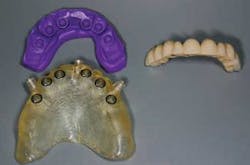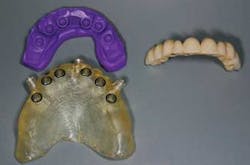Show Me the Way
by Paul Feuerstein, DMD
This year has seen a flurry of new products, procedures, and ideas across all areas of our profession. As a general practitioner, I have used several products including restorative products, bonding agents, and cements to name just a few. We have seen a cluster of new, sleek diode lasers from several companies that are affordable in cost and space requirements. Windows has given us a new operating system (not without controversy) while Apple has exploded with new products (including iPhone), as well as a new operating system of its own and a great new iMac that will also run Windows.
Not to be a broken record (for younger readers, this was a problem caused by a scratch in a groove of an LP that caused the stylus to skip and play the same clip over and over), but conebeam CT units have exploded into practices as previously noted in this column.
Some familiar names such as Kodak (ILUMA), Sirona (GALILEOS), Dent-X (NewTom), Imaging Sciences (iCat) and Planmeca (ProMax) have been joined by TerraRecon, E-WOO, and other new players in the dental arena. The competition is fierce and improvements and upgrades occur almost weekly.
Along with these amazing diagnostic devices comes a new group of software products that take data and reorganize it in a simple, useful format. Diagnosis of traditional problems such as third molars, growths, cysts, and developing dentition now can be seen with great clarity and diagnosed with more confidence.
The biggest effect, however, will be in the implant planning and placement world. Of the millions of implants being placed, most are done by specialists and a handful of GPs. Many of my peers think that, although they were trained in the basics of surgery, there are several unknowns in implant placement regarding bone and other anatomical structures.
Unfortunately, many implants have been placed in sinuses, lingual fossae, mandibular canals, and other incorrect areas. At the very least, this has resulted in failed cases and unhappy patients.
By using new software that is coordinated with CBCT scans, not only can implant placement become more predictable, but in many cases it can be done without reflecting a flap. This is due to computer-created "surgical guides."
In a partial dentition, the appliance looks similar to a nightguard, with a few holes and sleeves placed over the edentulous areas that will ultimately house the implant(s). Since the sleeve has been aligned to the precise angle and the program has instructed the dentist what the depth of the hole should be, the operator merely puts the depth stop on the drill and drops it through the hole.
The implant is then placed through the guide into the osteotomy and is ready for the cover, healing abutment, or even a provisional or final abutment if immediate loading is indicated.
In an edentulous mouth, the guide is slightly more elaborate. Since there is soft tissue and a chance for movement, it is actually fixed in place with horizontal anchor pins. If you observe these cases, it almost looks too simple. It is reminiscent of the old color-by-numbers method of creating art masterpieces, as long as you could stay inside the lines.
These guides are not a substitute for training and expertise, but they take the guesswork out of the process. This reminds me of Dr. Paul Vinton, the head of the prosthetics department of my dental school, the University of Medicine and Dentistry of New Jersey.
He would say that these are a "guide for the intelligent and a refuge for the stupid." The most visible systems are Nobel Biocare (NobelGuide) and Simplant. These two were released early, and had the marketing clout to become well known.
Now there are many. An incomplete list includes iDent, Biomedical Modeling, 3D Diagnostix, Implant Logic, CadImplant, DENX, Medical Modeling, Anatomage, Dolphin, 3dMD, and Medicim. In the future, I will offer a more comprehensive discussion of these products.
Nobel has coined the term "Teeth-in-an-Hour." This procedure not only uses a surgical guide to place the implants, but is coordinated with Nobel’s Procera system to allow prosthetics to be predesigned and fabricated prior to the surgery.
The system is so sure of the CBCT scans and software that titanium or zirconia frameworks can be fabricated and the provisional or final prosthesis delivered at the time of surgery.
Of course, this subscribes to the immediate load theories of implant placement, and requires much preplanning and operator expertise. While this column is not a forum for lengthy discussions on the pros and cons of this delivery, I hope this information encourages you to further study and inspect.
The key point is that more dentists are going to be capable of placing implants. Keep in mind that this technology does come at a significant cost to the dentist and patient. The notion that implants will become more affordable is feasible. But until systems become "commonplace," there is still a significant cost for the patient.
On the other hand, many patients resist being referred from a primary care office. The fact that it could be self-contained is a positive factor. Of course, there will be a financial return to the dentist since these more costly production procedures (and accompanying high-cost lab fees) are added to the daily mix. In addition, implant companies hope to increase production. This, in turn, results in more competition, which might be able to yield a slight cost reduction. A slight reduction in cost could also be evident.
Dental labs are gearing up for this explosion. One problem for labs is that machinery is costly, as is the training needed to implement the new CAD systems and associated computers and software. It would seem that larger labs will have an advantage. But there have been some enterprising labs that have become "labs for the labs." This procedure allows the local technician to submit complex frames, just as some have been doing for years, with partial dentures, but also add the finishing touches of esthetics and function — in much the same manner as they have done for dental clients in the past.
Some labs also are absorbing the cost of treatment planning software while offering this service to dentists. Dentists only have to send labs a CBCT scan and some models or impressions. In turn, they will receive all guides, drills, etc.
In my opinion, it is best for a practitioner to do the plan and design. But think of how many dentists have sent a model to the lab for a partial frame and expected the lab to design it. In time, this could follow the same pattern. I hope this is not the case. But for now, I am just trying to get dentists thinking about this subject.
Dentistry is not at a standstill. This is a great time to be a dentist, and, for that matter, to be a patient. Thanks for this goes to new technology. I guess my quest to bring you the latest developments will continue.
Dr. Paul Feuerstein installed one of dentistry’s first computers in 1978. For more than 20 years, he has taught technology courses. He is a mainstay at technology sessions, including annual appearances at the Yankee Dental Congress, and he is an ADA seminar series speaker. A general practitioner in North Billerica, Mass., since 1973, Dr. Feuerstein maintains a Web site (www.computersindentistry.com) and can be reached by e-mail at [email protected].



